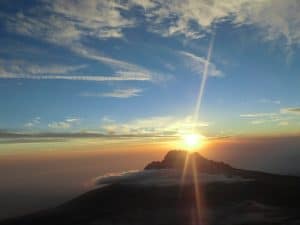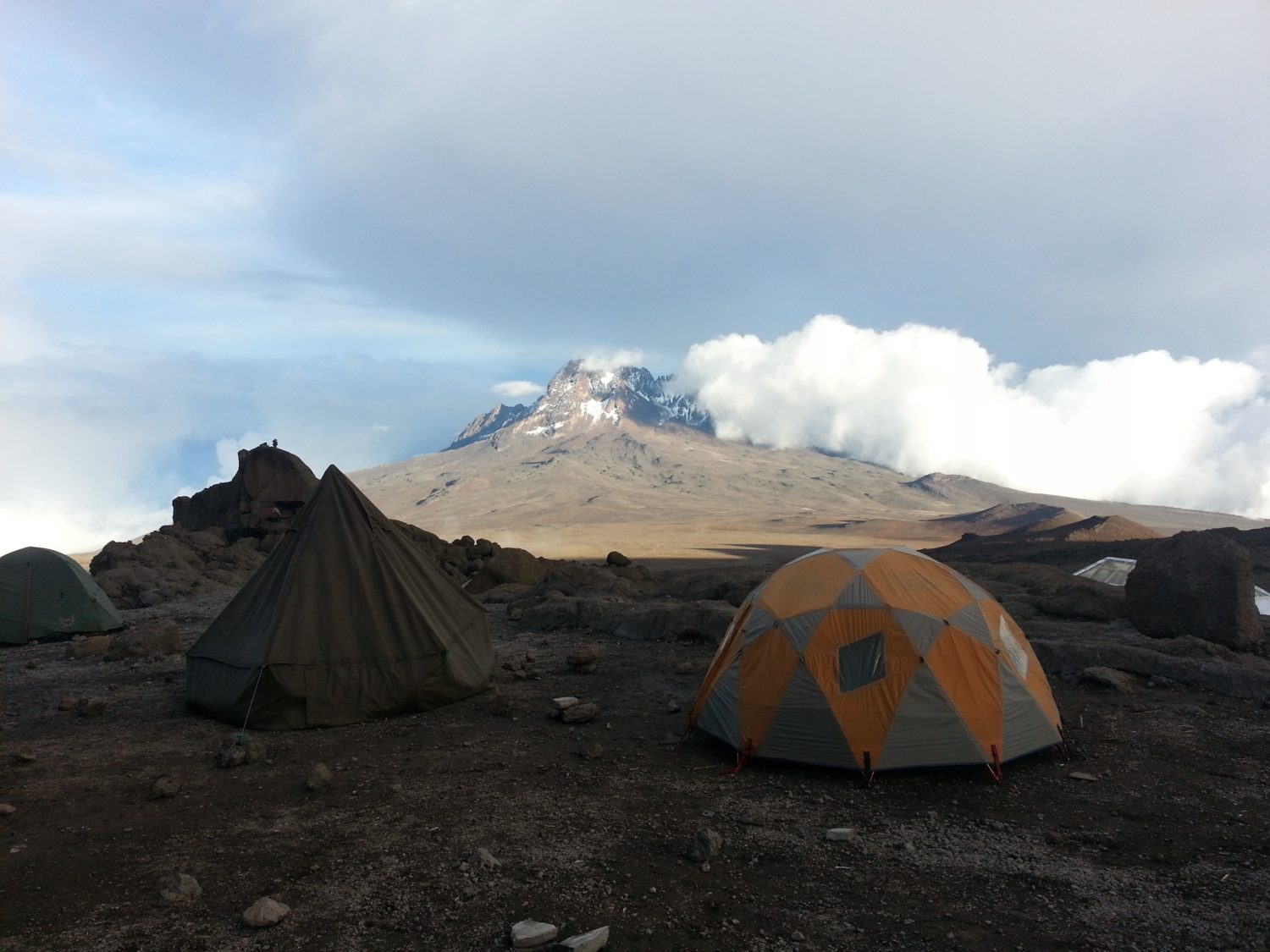 This is the newest, most exciting route on Kilimanjaro. The trek follows the Lemosho trail in the beginning, approaching Kilimanjaro from the west. However, instead of following the southern traverse like all the other west approaching routes, the Northern Circuit traverses the mountain around the quiet, rarely visited northern slopes. This is a nine day climb, which is the longest route in terms of time and distance travelled. Although it is the most expensive climb option, the small amount of climbers offers a secluded and unique experience, with a very high success rate.
This is the newest, most exciting route on Kilimanjaro. The trek follows the Lemosho trail in the beginning, approaching Kilimanjaro from the west. However, instead of following the southern traverse like all the other west approaching routes, the Northern Circuit traverses the mountain around the quiet, rarely visited northern slopes. This is a nine day climb, which is the longest route in terms of time and distance travelled. Although it is the most expensive climb option, the small amount of climbers offers a secluded and unique experience, with a very high success rate.
Price per person – USD
| Season | Twin Share | Single |
|---|---|---|
| 01 January to 31 December 2024 | On request | On request |
| 01 January to 31 December 2025 | On request | On request |
Number of Days: 9
Note:
- Departs daily subject to availability
- Twin share price based on minimum of 2 people
- Oxygen available at an additional cost
Package Includes:
- Park fees
- Camping fees
- Rescue fees
- Head guide
- Assistant guides
- Cook, & porters salaries
- All food
- Drinking water
- Tents
- Private toilet
- Transport to/from park entry gate.
Additional Costs:
- Hiring of clothing, sleeping mats, sleeping bags, walking poles etc.
- Tipping to your guides, cook and porters. The standard recommendation for this is USD$20 per day to the head guide, $12 per day to the assistant guide, $12 per day to the cook and $5 per day per porter. These costs are split between everyone doing the climb.
Day 1: Lemosho Trailhead (2,000m/6,600ft) to Big Tree Camp (2,800m/9,100ft)
Elevation Gain: 800 metres / 2,500 feet
This morning you will drive from Moshi to the Londorossi gate, taking approximately 3 hours. Here you will complete entry formalities. From Londorossi your drive continues for around 1 hour to the Lemosho trail head along a 4WD track. Upon arrival at the trail head you will eat lunch and then commence trekking through lush undisturbed forest where you may be lucky enough to see Colobus monkeys. The path undulates, steeply in places, to arrive at the first camp after 3-4 hours of trekking. Overnight at Big Tree Camp (Mti Mkubwa Camp).
Day 2: Big Tree Camp (2,800m/9,100ft) to Shira 1 Camp (3,500m/11,500ft)
Elevation Gain: 700 metres / 2,400 feet
Today your trek will begin in the forest; however you will soon leave this ecosystem behind taking a steep track into a zone of giant heather and volcanic rock. This is a full day ascending through the lush rolling hills below the Shira Plateau. Shira is the third of Kilimanjaro’s volcanic cones. It is filled with the lava flow from Kibo and its rim has eroded and been blasted away by weather and volcanic action. Finally the trail begins to ease as you reach the edge of the plateau. You will camp at Shira One after 5-6 hours of trekking. The view of Kibo from across the plateau is incredible.
Day 3: Shira 1 Camp (3,500m/11,500ft) to Shira 2 Camp (3,800m/12,500ft)
Elevation Gain: 300 metres / 1,000 feet
Your third day on the mountain consists of a trek across the Shira Plateau with an optional climb to Shira Cathedral (3,880m). Shira is one of the highest plateaus on earth. The day finishes with a gradual climb to Shira 2 Camp. Trekking time without the optional excursion is approximately 3 hours. Including the optional acclimatisation to the peak of Shira Cathedral will add approximately 1 hour.
Day 4: Shira 2 Camp (3,800m/12,500ft) to Moir Hut (4,200m/13,800ft) via Lava Tower (4,550m/14,900ft) (optional)
Elevation Gain: 750 metres / 2,400 feet (maximum)
Elevation Loss: 350 metres / 1,150 feet (maximum)
Your climb today will take you steadily up and over the expansive ridgelines of high desert en route to Moir Hut. If time and fitness allow it would be beneficial to ascend via the Lava Tower as this is a great opportunity to acclimatise. The trek to the base of Lava Tower is about 4 hours. This tower is a 300 foot high volcanic plug. If time and energy allow, you can scramble to the top of Lava Tower for fabulous panoramic views. From Lava Tower head North West beginning your circuit of Kibo, the almighty summit cone of Mount Kilimanjaro. Moir Hut Camp is an isolated and seldom used camp affording views over the Shira Plateau. Trekking time approximately 5-7 hours. An alternative to this route would be to take a gentle ascent across the alpine desert to Moir Hut in the morning and then spend the afternoon on a guided trek of the nearby Lent Group, a series of wind eroded parasite cones and ridges from whose upper slopes you can gaze down to the plains of Kenya in the north.
Day 5: Moir Hut Camp (4,200m/13,800ft) to Buffalo/Pofu Camp (4,020m/13,200ft)
Elevation Loss: 180 metres / 590 feet
Begin the morning trek heading out of the moorland and into the stark alpine desert, on a steep ridge off the main trail, beginning your venture on the Northern Circuit Route. If you chose not to explore the Lent Group yesterday, take a short detour to the top of Little Lent Hill (3,375m/14,350ft) in the morning before regaining the trail to Buffalo Camp. The total trekking time today is approximately 5 – 7 hours.
Day 6: Buffalo/Pofu Camp (4,020m/13,200ft) to Third Cave Camp (3,870m/12,700ft)
Elevation Loss: 150 metres / 500 feet
Proceed onward through valleys and over ridges through the alpine desert and moorland, continuing your circuit to the east. This rarely travelled route allows you to enjoy the vast mountain wilderness in peace. Trekking time today is 5 – 7 hours.
Day 7: Third Cave Camp (3,870m/12,700ft) to School Huts (4,750m/15,600ft)
Elevation Gain: 880 metres / 2,890 feet
Climb steadily to reach the Saddle, a lunar landscape between the peaks of Kibo and Mawenzi. From here, continue upwards to reach School Hut Campsite in the early afternoon. The remainder of the afternoon is spent resting and preparing for summit day, which will begin in the early hours of tomorrow morning. Trekking time approximately 4-5 hours today.
Day 8: School Huts (4,750m/15,600ft) to Uhuru Peak (5,895m/19,340ft) to Mweka Camp (3,110m/10,200ft)
Around midnight, begin the final ascent to Uhuru Peak, the highest point in Africa. For the next six to eight hours, hike by the light of your flashlight. It can be very cold at night at these elevations, but it will be quite warm by the end of the hiking day and therefore you will want clothing for both extremes. The ascent to the crater rim is the most challenging part of the entire trek. The trail is very steep until you reach the crater rim at Gilman’s Point. The hike from Gilman’s to Uhuru Peak is a gradual climb and, as far as hikes go, not very difficult. The altitude however makes the hike long and tiring. After summit celebrations you will descend to Kibo Huts. From the summit the descent will take you straight down to Mweka Hut, with lunch served on the way. This part of the descent takes about 6 hours. Later in the evening enjoy your last dinner on the mountain and a well-earned sleep. Beer and soda may be available for purchase at Mweka Hut, the only place it is available on this route.
Day 9: Mweka Camp (3,110m/10,200ft) to Mweka Gate (1,830m/6,000ft)
Elevation Loss: 1,280 metres / 4,220 feet
Descend straight to the gate through lush forest (2-3 hours), looking for monkeys along the way. Return to Moshi from Mweka Village.
Online Enquiry
Please fill out the below form and we will be in touch shortly.
"*" indicates required fields
We have a range of Tanzania tours & safaris available which can be customised with more or less nights as well as activities.
Please contact us for a quote for your desired itinerary or for more information on a Tanzania safari option.


